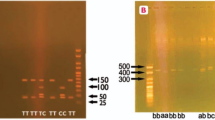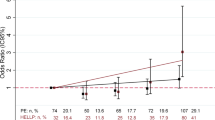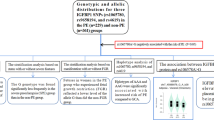Abstract
Studies showed elevated cell-free hemoglobin (Hb) in preeclampsia (PE), and Hb reacts with nitric oxide (NO), decreasing its bioavailability. Haptoglobin (Hp) is a polymorphic protein (Hp1-1, Hp2-1 and Hp2-2) that binds Hb to form a complex that is removed from circulation, thus preventing Hb-driven oxidative stress and NO scavenging. Hp protein products differ in biochemical and biophysical properties, which reflects on the Hb–Hp complex clearance rate. We hypothesized that Hp phenotypes modulate NO bioavailability by influencing NO consumption in PE. We studied 92 PE subjects and 105 normal pregnant women (NP). Hp genotypes were determined using real-time PCR. To assess NO bioavailability, we measured plasma nitrite using an ozone-based chemiluminescence assay. Plasma Hb and Hp were assessed with commercial immunoassays. A NO consumption assay was used to measure NO consumption. We found no differences in Hp genotype frequencies between PE and NP groups. Hp genotypes had no effects on plasma heme levels, NO consumption and plasma nitrite in NP. However, in PE, Hp2-1 and Hp2-2 were associated with higher plasma heme levels (48 and 55% higher, respectively; P<0.05), increased NO consumption (42 and 44% more, respectively; P<0.05) and lower plasma nitrite (39% less for Hp2-2; P<0.05) compared with Hp1-1. These findings indicate that although Hp genotype does not affect the risk of PE, Hp1-1 genotype may exert a protective role in PE by reducing NO scavenging, whereas Hp2-1 and Hp2-2 further may aggravate PE by reducing NO bioavailability.
This is a preview of subscription content, access via your institution
Access options
Subscribe to this journal
Receive 12 digital issues and online access to articles
$119.00 per year
only $9.92 per issue
Buy this article
- Purchase on Springer Link
- Instant access to full article PDF
Prices may be subject to local taxes which are calculated during checkout



Similar content being viewed by others
References
Sladek SM, Magness RR, Conrad KP . Nitric oxide and pregnancy. Am J Physiol 1997; 272 (2 Part 2): R441–R463.
Thornburg KL, Jacobson S-L, Giraud GD, Morton MJ . Hemodynamic changes in pregnancy. Semin Perinatol 2000; 24: 11–14.
Jim B, Sharma S, Kebede T, Acharya A . Hypertension in pregnancy: a comprehensive update. Cardiol Rev 2010; 18 (4): 178–189.
Palei AC, Sandrim VC, Cavalli RC, Tanus-Santos JE . Comparative assessment of matrix metalloproteinase (MMP)-2 and MMP-9, and their inhibitors, tissue inhibitors of metalloproteinase (TIMP)-1 and TIMP-2 in preeclampsia and gestational hypertension. Clin Biochem 2008; 41 (10-11): 875–880.
Sandrim VC, Montenegro MF, Palei AC, Metzger IF, Sertorio JT, Cavalli RC et al. Increased circulating cell-free hemoglobin levels reduce nitric oxide bioavailability in preeclampsia. Free Radic Biol Med 2010; 49 (3): 493–500.
Levine RJ, Maynard SE, Qian C, Lim KH, England LJ, Yu KF et al. Circulating angiogenic factors and the risk of preeclampsia. N Engl J Med 2004; 350 (7): 672–683.
Sankaralingam S, Xu H, Davidge ST . Arginase contributes to endothelial cell oxidative stress in response to plasma from women with preeclampsia. Cardiovasc Res 2010; 85 (1): 194–203.
Wikstrom AK, Nash P, Eriksson UJ, Olovsson MH . Evidence of increased oxidative stress and a change in the plasminogen activator inhibitor (PAI)-1 to PAI-2 ratio in early-onset but not late-onset preeclampsia. Am J Obstet Gynecol 2009; 201 (6): 597 e591–597 e598.
Sandrim VC, Palei AC, Metzger IF, Cavalli RC, Duarte G, Tanus-Santos JE . Interethnic differences in ADMA concentrations and negative association with nitric oxide formation in preeclampsia. Clin Chim Acta 2010; 411 (19–20): 1457–1460.
Sandrim VC, Palei AC, Cavalli RC, Araujo FM, Ramos ES, Duarte G et al. eNOS haplotypes associated with gestational hypertension or preeclampsia. Pharmacogenomics 2008; 9 (10): 1467–1473.
Azarov I, He X, Jeffers A, Basu S, Ucer B, Hantgan RR et al. Rate of nitric oxide scavenging by hemoglobin bound to haptoglobin. Nitric Oxide 2008; 18 (4): 296–302.
Reiter CD, Wang X, Tanus-Santos JE, Hogg N, Cannon RO, Schechter AN et al. Cell-free hemoglobin limits nitric oxide bioavailability in sickle-cell disease. Nat Med 2002; 8 (12): 1383–1389.
Pacher P, Beckman JS, Liaudet L . Nitric Oxide and Peroxynitrite in Health and Disease. Physiol Rev 2007; 87 (1): 315–424.
Wagener FA, Eggert A, Boerman OC, Oyen WJ, Verhofstad A, Abraham NG et al. Heme is a potent inducer of inflammation in mice and is counteracted by heme oxygenase. Blood 2001; 98 (6): 1802–1811.
Levy AP, Asleh R, Blum S, Levy NS, Miller-Lotan R, Kalet-Litman S et al. Haptoglobin: basic and clinical aspects. Antioxid Redox Signal 2010; 12 (2): 293–304.
Bowman BH, Kurosky A . Haptoglobin: the evolutionary product of duplication, unequal crossing over, and point mutation. Adv Hum Genet 1982; 12 (189-261): 453–184.
Wejman JC, Hovsepian D, Wall JS, Hainfeld JF, Greer J . Structure and assembly of haptoglobin polymers by electron microscopy. J Mol Biol 1984; 174 (2): 343–368.
Edwards DH, Griffith TM, Ryley HC, Henderson AH . Haptoglobin-haemoglobin complex in human plasma inhibits endothelium dependent relaxation: evidence that endothelium derived relaxing factor acts as a local autocoid. Cardiovasc Res 1986; 20 (8): 549–556.
Wang X, Tanus-Santos JE, Reiter CD, Dejam A, Shiva S, Smith RD et al. Biological activity of nitric oxide in the plasmatic compartment. Proc Natl Acad Sci USA 2004; 101 (31): 11477–11482.
Sammour RN, Nakhoul FM, Levy AP, Miller-Lotan R, Nakhoul N, Awad HR et al. Haptoglobin phenotype in women with preeclampsia. Endocrine 2010; 38 (2): 303–308.
Anonymous. Report of the National High Blood Pressure Education Program Working Group on High Blood Pressure in Pregnancy. Am J Obstet Gynecol 2000; 183 (1): S1–S22.
Pelletier MM, Kleinbongard P, Ringwood L, Hito R, Hunter CJ, Schechter AN et al. The measurement of blood and plasma nitrite by chemiluminescence: Pitfulls and solution. Free Radic Biol Med 2006.
Soejima M, Koda Y . TaqMan-based real-time PCR for genotyping common polymorphisms of haptoglobin (HP1 and HP2). Clin Chem 2008; 54 (11): 1908–1913.
Olsson MG, Centlow M, Rutardottir S, Stenfors I, Larsson J, Hosseini-Maaf B et al. Increased levels of cell-free hemoglobin, oxidation markers, and the antioxidative heme scavenger alpha(1)-microglobulin in preeclampsia. Free Radic Biol Med 2010; 48 (2): 284–291.
Centlow M, Carninci P, Nemeth K, Mezey E, Brownstein M, Hansson SR . Placental expression profiling in preeclampsia: local overproduction of hemoglobin may drive pathological changes. Fertil Steril 2008; 90 (5): 1834–1843.
Rother RP, Bell L, Hillmen P, Gladwin MT . The clinical sequelae of intravascular hemolysis and extracellular plasma hemoglobin: a novel mechanism of human disease. JAMA 2005; 293 (13): 1653–1662.
Jeffers A, Gladwin MT, Kim-Shapiro DB . Computation of plasma hemoglobin nitric oxide scavenging in hemolytic anemias. Free Radic Biol Med 2006; 41 (10): 1557–1565.
Asleh R, Marsh S, Shilkrut M, Binah O, Guetta J, Lejbkowicz F et al. Genetically determined heterogeneity in hemoglobin scavenging and susceptibility to diabetic cardiovascular disease. Circ Res 2003; 92 (11): 1193–1200.
Levy AP, Purushothaman KR, Levy NS, Purushothaman M, Strauss M, Asleh R et al. Downregulation of the hemoglobin scavenger receptor in individuals with diabetes and the Hp 2-2 genotype: implications for the response to intraplaque hemorrhage and plaque vulnerability. Circ Res 2007; 101 (1): 106–110.
Komori H, Watanabe H, Shuto T, Kodama A, Maeda H, Watanabe K et al. alpha1-acid glycoprotein up-regulates CD163 via TLR4/CD14 pathway: possible protection against hemolysis-induced oxidative stress. J Biol Chem 2012; 287: 30688–30700.
Weissgerber TL, Roberts JM, Jeyabalan A, Powers RW, Lee M, Datwyler SA et al. Haptoglobin phenotype, angiogenic factors, and preeclampsia risk. Am J Obstet Gynecol 2012; 206 (4): 358 e310–358 e358.
Chandra TPT, Vishnupriya S, Venkat Raman R . Haptoglobin polymorphism in pregnancy-induced hypertension. Am J Hum Genet 1991; 49: 130.
Kato GJ, Gladwin MT . Evolution of novel small-molecule therapeutics targeting sickle cell vasculopathy. JAMA 2008; 300 (22): 2638–2646.
Alexander BT, Llinas MT, Kruckeberg WC, Granger JP . L-arginine attenuates hypertension in pregnant rats with reduced uterine perfusion pressure. Hypertension 2004; 43 (4): 832–836.
Ramesar SV, Mackraj I, Gathiram P, Moodley J . Sildenafil citrate improves fetal outcomes in pregnant, L-NAME treated, Sprague-Dawley rats. Eur J Obstet Gynecol Reprod Biol 2010; 149 (1): 22–26.
George EM, Arany M, Cockrell K, Storm MV, Stec DE, Granger JP . Induction of heme oxygenase-1 attenuates sFlt-1-induced hypertension in pregnant rats. Am J Physiol Regul Integr Comp Physiol 2011; 301 (5): R1495–R1500.
Acknowledgements
This study was funded by Fundação de Aparo a Pesquisa do Estado de São Paulo (FAPESP-Brazil), Conselho Nacional de Desenvolvimento Científico e Tecnológico (CNPq-Brazil) and Coordenadoria de Aperfeiçoamento de Pessoal de Nível Superior (CAPES-Brazil). We thank Dr Yoshiro Koda and co-workers for their help in adapting the haptoglobin genotyping method in our laboratory, and Dr Maria Sonati and Dr Tania Zaccariotto for kindly providing previously sequenced DNA samples that were used as positive controls for each genotype.
Author information
Authors and Affiliations
Corresponding author
Ethics declarations
Competing interests
The authors declare no conflict of interest.
Rights and permissions
About this article
Cite this article
Sertório, J., Lacchini, R., Amaral, L. et al. Haptoglobin polymorphism affects nitric oxide bioavailability in preeclampsia. J Hum Hypertens 27, 349–354 (2013). https://doi.org/10.1038/jhh.2012.57
Received:
Revised:
Accepted:
Published:
Issue Date:
DOI: https://doi.org/10.1038/jhh.2012.57



